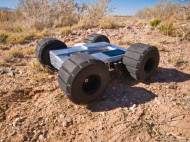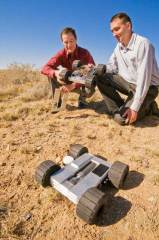Sandia Precision Urban Hopper robot jumps over high obstacles
 In our previous article we noted that we’re describing one of the Boston Dynamics new robots, and in this article we’re going to write about a robot that served as a base for their next robot in development. Boston Dynamics, the developer of advanced dynamic robots such as BigDog and PETMAN, has been awarded a contract by Sandia to develop the next generation of the Precision Urban Hopper robot, thus preparing it for potential military usage.
In our previous article we noted that we’re describing one of the Boston Dynamics new robots, and in this article we’re going to write about a robot that served as a base for their next robot in development. Boston Dynamics, the developer of advanced dynamic robots such as BigDog and PETMAN, has been awarded a contract by Sandia to develop the next generation of the Precision Urban Hopper robot, thus preparing it for potential military usage.
“When fully operational, the four-wheeled hopper robots will navigate autonomously by wheel and jump – with one mighty leg – onto or over obstacles of more than 25 feet”, said Jon Salton, Sandia program manager. He added: “The Precision Urban Hopper is part of a broad effort to bolster the capabilities of troops and special forces engaged in urban combat, giving them new ways to operate unfettered in the urban canyon,”
As part of the ongoing DARPA project, Sandia developed the shoebox-sized, GPS-guided, unmanned ground robots. The demonstrated hopping capability of the robots allows the small unmanned ground vehicles to overcome as many as 30 obstacles that are 40-60 times their own size. Hopping mobility has been shown to be five times more efficient than hovering when it jumps over obstacles at heights smaller than 10 meters, which allows longer station-keeping time for the same amount of fuel.
“An overall goal of the robots is to decrease the number of casualties in combat. To that end, the hopping robots will provide enhanced situational awareness for shaping the outcome of the immediate local combat situation”, Salton said.
The wheeled robotic platform adapts to the urban environment in real time and provides precision payload deployment to any point of the urban jungle while remaining lightweight and small. Researchers addressed several technical challenges, including appropriate management of shock forces during landing, controlling hop height from varying terrain including concrete, asphalt, sand and vegetation and controlling landings to limit tumbling.
”We are delighted to win this project and get a chance to work with Sandia on such a novel and potentially useful robot,” said Marc Raibert, president and founder of Boston Dynamics. “The program gives us a chance to apply our special brand of advanced controls and stabilization to a system that can help our warfighters in the near future.”
In addition to providing military assistance, the hopping capabilities of the robots could be used in law enforcement, search and rescue applications in challenging terrain and in planetary exploration. Their compact, lightweight design makes them portable, and their semiautonomous capability greatly reduces the workload burden of the operator. Testing and delivery are planned for late 2010, so we’re yet going to see its full capabilities.










Leave your response!